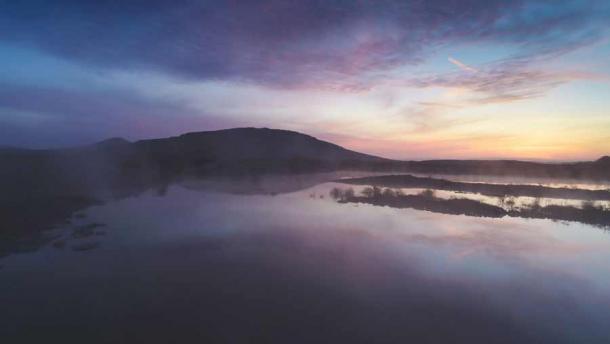RTÉ, Ireland’s National Television and Radio Broadcaster, recently brought to our screens filmmaker Katrina Costello’s bold and groundbreaking two-part documentary – The Burren: Heart of Stone . Thirteen years in the making, the docuseries confirms the story of evolution, humanity’s African origins and that prehistoric Irish people, hunter-gatherers from 10,000 years ago, were dark-skinned and had blue eyes.
Located in the countryside of County Clare in southwest Ireland, the Burren has always been a place full of intrigue and mystery, replete with deep caves, rocky and stony landscapes (from where the titular name originates), dominated by glaciated karst. It is also renowned for its historic ancient Dolmens, from the early Neolithic. Narrated by legendary Irish actor and performer, Brendan Gleeson, the documentary explores the question of whether the modern Irish have descended from this era of pre-historic hunter-gatherers.

The docuseries, created by Katrina Costello, focuses on the Burren. This unique landscape reveals unexpected details about the ancient Irish and their genetic history. ( RTE)
The Science of DNA in the Ancient Irish
While the first part is a fabulous documentation about the ecology and geology of the Burren, landscape formation and the shells of ancient marine creatures embedded beneath many layers, our focus is on the second part of this riveting documentary. Titled Symphony of Life , it prominently features professionals and experts, such as the geneticist Dr. Lara Cassidy, from the highly reputed Trinity College Dublin, who sheds light on the process of DNA sequencing (also known as Sanger’s method).
In layman terms, one of the key contributions of DNA sequencing is performing genetic mapping to help understand disease, for example in a DNA pool, or for our purposes, ancestry. The episode focuses on the Mesolithic hunter-gatherer population, who were dark-skinned and had blue eyes, and occupied the region some 10,000 years ago, only to be replaced by another wave of inhabitants 4,000 years later. DNA examination of bones showed the Irish hunter-gatherer people had dark or black skin with blue eyes. They were taller than the sallow-skinned farmers and builders who replaced them.
In fact, a fascinating University of Copenhagen study from 2008 was one of the first accredited and reputed publications to showed that people with blue eyes have a single, common ancestor. Between 6,000 to 10,000 years ago, every human being had brown eyes, but a genetic mutation affecting the OCA2 genes in our chromosomes caused this phenomenon to occur. Once again this case emphasizes the interconnectedness of all human beings, now and in the past.
Dr. Cassidy, according to Irish Times , said that techniques used in forensic criminal investigations were employed for this exercise. That helped reveal that the arriving hunter-gatherers did not have any of the pigmentation profiles associated with light skin. It was only 6,000 years ago that the next wave of settler inhabitants arrived, with different skin profiles and the customs of settled agriculture. Interestingly, bone fragments found in the Burren caves and megalithic tombs shows a direct link between the hunter-gatherers and the settlers who arrived after.
The Burren: Heart of Stone – Episode Two ‘Song of our Ancestors’ from Sea Fever on Vimeo.
Tracing the Human History of Irish Genes
The “Irish” hunter-gatherers were nomads practicing shifting agriculture, living on the margins of the forests in the Burren . They practiced fishing and hunting animals, and gathered nuts and berries. They largely lived in temporary wooden settlements, which they abandoned after judicious use of the resources in a certain area. This explains why there was no lasting impression left on the environment or landscape.
4,000 years after their arrival, a large influx of distinctly different people, with sallow skin and dark eyes arrived. These new arrivals practiced farming, and built the stone walls and the large megaliths that are loosely scattered all over the Burren today. According to the Independent Ireland , Dr. Cassidy said that “the bone fragments of an entombed member of the newer farmer population showed one of the farmer’s recent ancestors, potentially a great grandparent, was a member of the earlier hunter-gatherer population.”
Heading into the Bronze Age, roughly 4,500 years ago, these settlers would become the dominant population. Fascinatingly enough, Dr. Cassidy adds that there is a strong genetic continuity between the Bronze Age settlers and the modern Irish, though gene pools are a constantly evolving process. To add to these revelations, the carbon dating of a reindeer showed that it was butchered 33,000 years ago, showing that human activity in ancient Ireland pre-dated what was earlier believed, forever changing our understanding of human history in Ireland and northwest Europe.
Top image: The stunning documentary confirms that prehistoric Irish people were dark-skinned and had blue eyes. Source: Sea Fever / RTE
By Rudra Bhushan
Related posts:
Views: 0
 RSS Feed
RSS Feed

















 April 22nd, 2021
April 22nd, 2021  Awake Goy
Awake Goy  Posted in
Posted in  Tags:
Tags: 
















